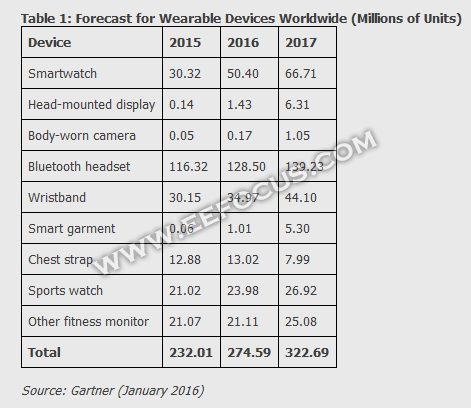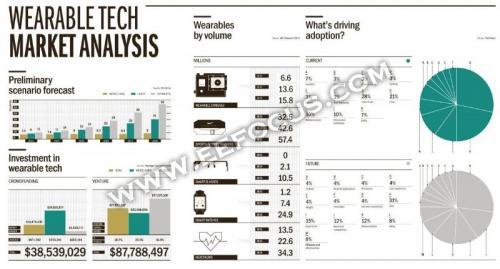可穿戴技术的十大看点
发布日期:2023-07-31
点击次数:799
现在可穿戴设备市场虽不成熟,但依然在增长。现在全球可穿戴设备约有160个种类,例如轨迹追踪设备、智能手表、智能眼镜以及安全在衣服里的嵌入式传感器等,IDTechEX预测未来十年可穿戴设备市场可达700亿美元。随着技术进步与新产品地不断推出,可穿戴产品正在快速地进入人类生活并改变人类生活方式。可穿戴产品的一大分支是健康医疗类可穿戴产品,例如看护老人和婴儿的设备、监控睡眠和健康状况的可穿戴设备,当然现在销量最好的可穿戴设备是智能手表和运动手环。
Gartner预测2016年全球可穿戴设备出货量可达2.746亿台,比2015年2.32亿出货量增长18.4%。2016可穿戴设备销售额可达287亿美元,其中智能手表约为115亿美元。



“依靠苹果产品引领潮流的能力,从2015年至2017年,智能手表接受率将上升48%。从现在到2019年,智能手表都可能是可穿戴市场最大的分支,销售额可达175亿美元。”Gartner在报告中说。
未来几年,可穿戴技术的十大看点如下:
1.机会大:根据普华永道的预测,娱乐、媒体及通信(Entertainment, media & Communications,简称EMC,小编语:乱造缩写可耻)行业将为可穿戴市场的成长创造最大机会。基本上,只要有屏幕的应用,就会有可穿戴的机会,而EMC行业正是这样的应用。估计不错的话,2018年可穿戴产品在这些 2.行业里面的出货量可达1.3亿台,这自然是个大机会。
2.人性化选择设备:用户可能会需要更人性化的方式选择设备及其相关应用(app)。例如用一个经过医疗专业人员认证过的“应用处方表(apps formulary)”来帮助用户从上千个健康应用与设备中选择出合适的设备与应用。
3.可穿戴设备将受益于社交媒体: 社交媒体已经成为接收信息和与他人交流的基本方式。借助可穿戴设备,正好可以满足用户随时随地访问社交网络的需求。千禧一代更新社交媒体的频率是普通人的三倍,社交媒体将使可穿戴设备大大受益。
4.辅助治疗慢性病是可穿戴产品成长的驱动力之一:从美国的情况来看,消费与医疗类应用也是驱动可穿戴市场增长的动力之一。尤其随着糖尿病等慢性病发病率的上升,可穿戴式产品的市场空间越来越大,运动手环与智能手表等也将健康功能集成进来,但这些产品在健康医疗方面的应用表现尚不能令人满意。
5.利用可穿戴技术收集数据:利用可穿戴设备收集的数据,保险公司或雇主可以更好的管理健康医疗成本,医药与生命科学公司可以做更多的临床试验,医疗服务公司根据收集到的数据决定报销费用。随着计算能力地不断增强,可穿戴设备尺寸变得很小,因此深受年轻人的欢迎。他们将记录健身数据的手表、心率监控以及其他可穿戴健康设备通过一个iPhone应用把这些有价值的健康数据传送到千里之外。当然商业公司收集这些数据需要考虑成本、用户隐私以及易用性。
6.吸引健康意识强的用户关注:从记录心率的智能手表到追踪运动轨迹的智能手环,越来越多健康意识强的用户开始关注可穿戴技术在医疗健康方面的应用。发展可穿戴技术的两大目的之一就是检测用户的身体状态并将这些数据同步到智能手机等父设备上,当然一些可穿戴设备本身也可以在该设备上进行计算,根据计算结果执行相应的动作,例如是否需要给患者使用药物。
7.新应用价值挖掘:很多大公司开始推出智能手表和智能手环。随着苹果和三星这样巨头的加入,可穿戴产品的外观与用户体验将大幅提升。Fitbit这样的智能手环元老厂商开始要考虑如何与智能手表竞争。除了健身应用以外,智能手环正在拓展新的应用场景,例如移动支付、身份认证、安全以及健康。
8.健身应用:在美国,由于政府健康项目的推动,包括智能手环、智能衣服、智能胸带、智能运动手表等健身应用类可穿戴设备越来越受欢迎。2016年,这类型应用中智能手表将最受欢迎,因为智能手表集成了多种功能方便用户跟踪锻炼结果。
9.带来新技术:在可穿戴领域要获得用户的信任,企业必须始终坚持把数据操作透明化,对这些关乎用户隐私的数据,企业需要告诉用户对这些数据进行了什么样的操作以及这些数据将会用于什么场合。基于有机电子的可穿戴技术现在可以制造出柔性显示屏和传感器,这些技术应用广泛,可穿戴设备、移动设备、工业设备、汽车以及生物医疗设备都可以使用。
10.拥抱可穿戴技术:必须以用户为中心,围绕提高用户体验来重塑企业价值观及系统能力,才能更有效地发展可穿戴技术。现在可穿戴产品大多用于手腕佩戴,但随着柔性电路的发展,可穿戴设备将越来越多地以其他形式来出现,例如衣服、配饰以及鞋子。可穿戴设备及应用帮助用户记录心率与用餐状况,监控用户心理状况,甚至可以检测周围的空气质量,对于普通人来说,做一个“健康的我”成为现实。
总结
市场分析机构CSC Insight表示可穿戴设备出货量将从2014年的2900万增长到2018年的1.72亿,峰值出现在2015年,Fitbit和Jawbone仍将统治可穿戴市场。CSC Insight预计2016年健身及活动追踪类可穿戴设备出货量将达到4000万,比2015年翻一番。2020年全球可穿戴市场规模可达312.7亿美元,从2015年至2020年的年复合增长率达17.8%。

虽然可穿戴设备市场前景看好,但是可穿戴设备被用户接受将是一个长期的过程。现在将可穿戴设备用于商业用途是很多公司开始考虑的方向。










